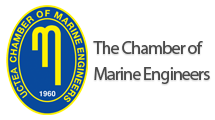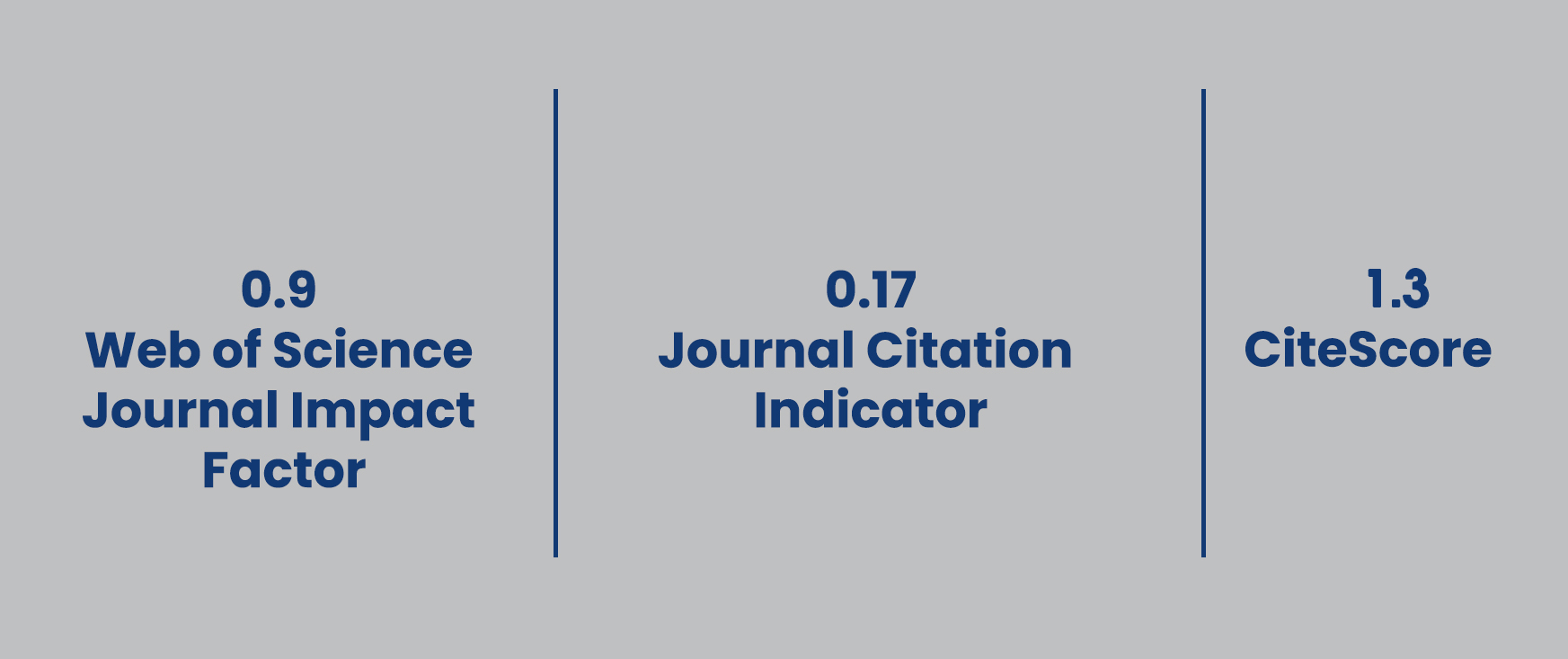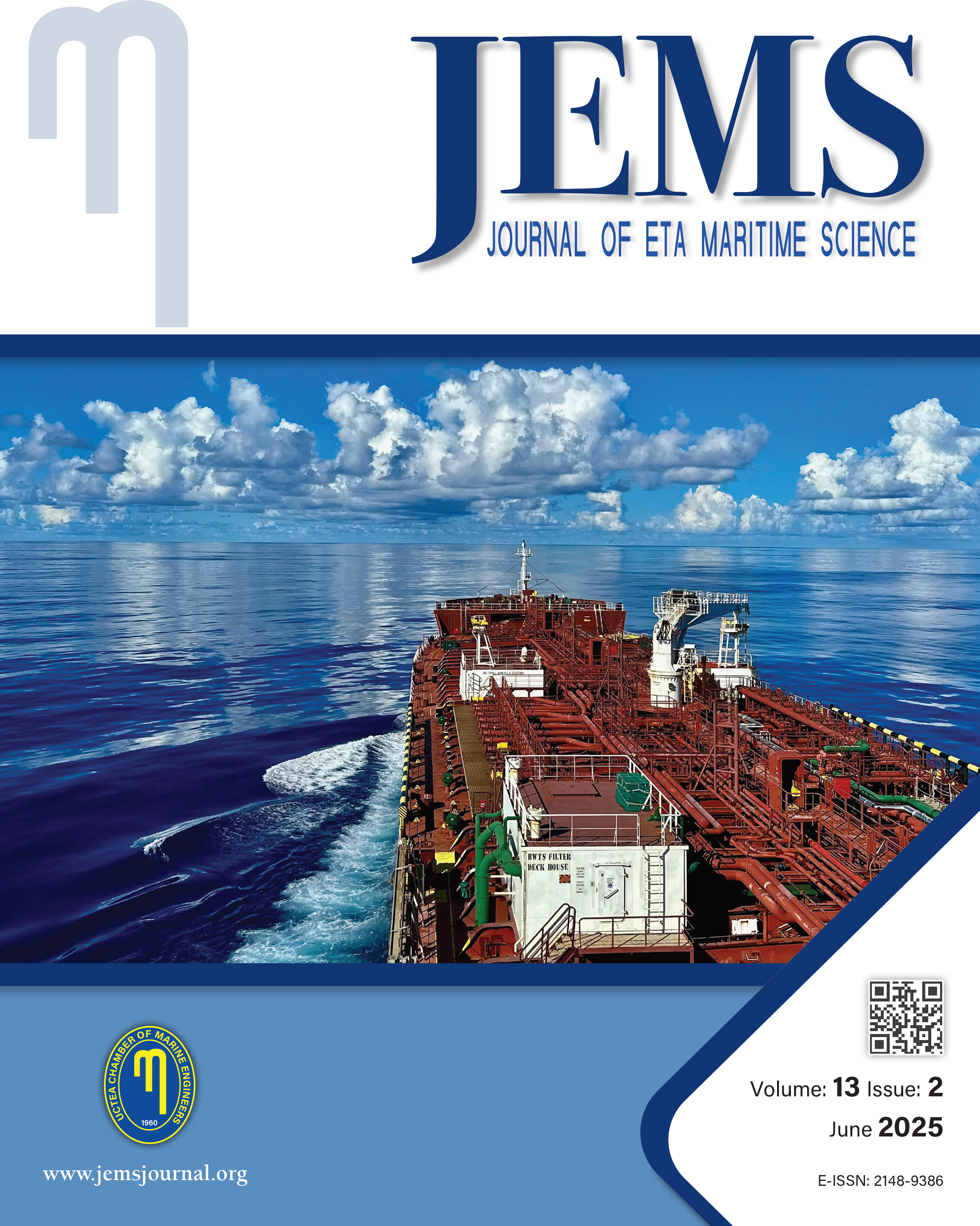

JEMS apply the Creative Commons Attribution NonCommercial 4.0 International Licence to all manuscripts to be published
ABSTRACTING & INDEXING
Volume: 12 Issue: 4 - 2024
| 1. | Full Issue Page I |
| EDITORIAL (ED) | |
| 2. | Editorial Selçuk Nas doi: 10.4274/jems.2024.36450 Page 357 Abstract | |
| ORIGINAL RESEARCH (AR) | |
| 3. | Astern Running of Heavy-Tonnage Vessels in an Ice Channel Aleksei Dobrodeev, Kirill Sazonov doi: 10.4274/jems.2024.50480 Pages 358 - 364 One of the most important tasks in raising the efficiency of marine transport systems is to make heavy-tonnage vessels move at faster speeds in channels laid by icebreakers. Studies conducted in the Krylov State Research Center (KSRC) Ice Basin have shown that broken ice is a significant factor that restricts vessel speed through ice channels. Wide breadths of heavy-tonnage vessels make it difficult to push ice pieces aside, resulting in their accumulation ahead of the bow. Ice blocks can be removed from the bow area only if they are immersed and passed along the hull underwater. With increasing speed, these processes require increasing amounts of energy. Possibly, easy ice passage along the underwater hull and speed improvements can be achieved if large-size vessels go stern first in ice channels. In this mode of operation, we have a number of factors contributing to the more efficient passage of ice provided by the small angle of the sternpost, making it easier for ice floes to dive under the hull, as well as the suction produced by the propellers. Moreover, the propeller slipstreams wash away the submerged ice outside the channel edges and reduce the ice friction of the underwater hull. This paper provides some theoretical assessments regarding the efficiency of running a large-sized vessel astern in an ice channel. Model studies have been undertaken in the KSRC Ice Basin to confirm that the suggested mode of operation is effective. During these experiments, models of large vessels were run through an ice channel to determine their ice resistance and speed. The theoretical estimates were compared with the model test results obtained for the Ice Basin. The analysis of all results proves that the described mode of operation promises faster vessels through ice channels. |
| 4. | State Estimation and Control for a Model Scale Passenger Ship using an LQG Approach Ferdi Çakıcı, Ahmad Irham Jambak, Emre Kahramanoğlu, Ahmet Kaan Karabüber, Bünyamin Ustalı, Mehmet Utku Öğür, Fuat Peri, Ömer Sinan Şahin, Mehmet Akif Uğur, Afşin Baran Bayazit doi: 10.4274/jems.2024.00236 Pages 365 - 376 Reducing the roll response of ships between irregular waves is an important issue for the operational requirement. This study presents a roll dynamics model for a passenger ship equipped with active fins. In this study, a Kalman Filter was applied to accurately estimate all states from the measurement of total roll motion and roll velocity (based on fins and waves), even in the presence of measurement noise. Synchronously, a linear quadratic gaussian (LQG) controller actively drives the fins to minimize roll motion and velocity by taking the fin amplitude and rate saturations together. Two different sea states were modeled for the simulation purpose. Results demonstrate the success of the state estimation approach and the remarkable potential of the LQG strategy in roll reduction. |
| 5. | A Conceptual COLREGs-based Obstacle Avoidance Algorithm Implementing Dynamic Path Planning and Collision Risk Assessment Hasan Uğurlu, Omar Djecevic, Ismail Çiçek doi: 10.4274/jems.2024.35682 Pages 377 - 394 This paper introduces an algorithm for collision avoidance systems intended for Maritime Autonomous Surface Ships. The algorithm takes into account the rules defined by the International Regulations for Preventing Collisions at Sea (COLREGs) and is tailored for real-world maritime environments. Analysis of collision accidents highlights human error and non-compliance with COLREGs as primary contributing factors. Employing the COLREGs as foundational design criteria can mitigate these factors. The algorithm also has the potential to serve as a decision support system on currently manned vessels, enhancing safe navigation. The study proposes a novel rule-based collision avoidance algorithm that adheres to COLREGs, utilizes the Collision Risk Index and ship domain for safety assessment, and combines dynamic path planning for collision-free navigation. Leveraging the Automatic Identification System, which is present on all ships navigating international waters, the algorithm achieves target detection. The algorithm was applied to simulate past ship-to-ship collision incidents, considering the ship kinematics, dynamics, and maneuverability resulting in successful prevention of such accidents through the proposed approach. |
| 6. | Strategic Ship Fleet Planning for Crude Palm Oil Marine Transportation: A Case Study in Indonesia Achmad Riadi, Muhammad Hanif Fajri Ramadhan doi: 10.4274/jems.2024.28863 Pages 395 - 403 This paper presents the application of strategic ship fleet planning for the maritime transportation of crude palm oil. This study aims to determine the optimal number of chemical tankers required, their capacity (in deadweight tonnage), and the appropriate timing for chartering, buying, or selling vessels within the fleet. To achieve this, mixed integer linear programing is utilized as the optimization framework for strategic ship fleet planning. To ensure a more authentic approach, the investigation utilized a case study focused on the export of Indonesian crude palm oil. The research findings indicate that several export routes cannot be serviced due to higher transportation costs, which could potentially be anticipated through an increase in freight rates. In addition, decisions regarding the quantity and categories of fleets required for each transportation route were also made. The importance of this study is highlighted by its capacity to offer valuable insights to exporters, shipping companies, and the government regarding tanker fleet deployment, management, and regulatory considerations. Furthermore, these findings provide a clearer understanding of the necessity of a tanker fleet for transporting crude palm oil. This supports the Indonesian governments beyond cabotage policy, which mandates the use of vessels operated by national shipping companies for crude palm oil exports, making it a relevant case study for examining the effectiveness of such measures. |
| 7. | A Dynamic Discretization Algorithm for Learning BN Model: Predicting Causation Probability of Ship Collision in the Sunda Strait, Indonesia Iis Dewi Ratih, Ketut Buda Artana, Heri Kuswanto, Dhimas Widhi Handani, Renata Zahabiya doi: 10.4274/jems.2024.99075 Pages 404 - 417 Ship collisions represent a significant category of maritime accidents with far-reaching consequences that cause damage to the involved ship and neighboring vessels. This poses a threat to the marine environment, leading to potential oil spills and the triggering of additional maritime accidents. Therefore, predicting the frequency of ship collisions by identifying the contributing factors is crucial as an initial step in preventing and mitigating their occurrence. Causation probability refers to the likelihood of events resulting from a ship collision. The contributing factors to ship collisions include weather conditions, technical failure, insufficient resources, navigation errors, human error, and the failure of other vessels. The Bayesian Network (BN) machine learning method is capable of predicting ship collisions. This method delineates the relationships among diverse and complex random variables in the form of a diagram grounded in conditional probability theory. It considers both categorical and continuous variables. The prediction of ship collisions through the application of the BN involves the use of a dynamic discretization algorithm, which offers advantages over static discretization. In this research, the causation probability of ship collisions in the Sunda Strait, Indonesia was predicted. This endeavor is necessary because of the distinct characteristics inherent to each geographical area, which implies the likelihood of varying causation probabilities across regions. The resulting predictive model for the likelihood of ship collisions in the Sunda Strait, Indonesia, derived from the implementation of the BN with the dynamic discretization algorithm, yields causation probabilities of head-on collision at 2.74x10-4, overtaking at 9.84x10-4, and crossing at 8.41x10-5. The model demonstrated an overall accuracy of 94.74%. |
| 8. | Analysis of the Strain-Dependent Damping of Paulownia Wood to Reduce Vibrations in Maritime Transport Jürgen Göken, Nicolas Saba doi: 10.4274/jems.2024.78736 Pages 418 - 426 The shipping industry is striving to optimise efficiency and safety regarding sound and vibration protection through innovations. A key aspect of these innovations is the development of new insulation materials that help minimise vibrations and noise. In addition to protecting the ship's structures, the protection of the crew members is also of great importance. Noise pollution and persistent vibrations can adversely affect the health and well-being of the crew. This, in turn, can reduce performance and responsiveness in critical situations. Paulownia wood is an innovative natural product and a fast-growing and lightweight wood that can be cultivated worldwide. In light of the increasing interest in sustainable building materials and the growing demand for lightweight construction solutions, especially in shipbuilding, it is crucial to better analyse and hence understand the damping potential of Paulownia wood which significantly affects its acoustic behaviour. Damping was investigated by measuring the logarithmic decrement of freely decaying bending oscillations as a function of the maximum strain amplitude. The measurements were carried out on a common Paulownia species (obtained from plantations in Georgia, Italy, and Spain) and a new species of Paulownia obtained from a plantation in Germany. It was found that all damping curves exhibited a strain-independent and a strain-dependent range. Moreover, it was shown that the influence of the fibre orientation on the damping behaviour was less than expected. |
| 9. | Strategic Management Modeling for Offshore Tugboat and Support Vessel Operations: A Hybrid SWOT-TOWS Fuzzy DEMATEL-TOPSIS Framework Ali Burçin Eke, Ozan Batmaz, Muhammed Fatih Gülen, Esma Uflaz, Özcan Arslan doi: 10.4274/jems.2024.80774 Pages 427 - 445 The maritime sector, particularly in offshore tugboat and support vessel operations, faces multifaceted strategic management challenges due to rapid technological advancements, environmental regulations, and market conditions. This paper introduces an innovative strategic decision-making framework for this industry, integrating Strengths, Weaknesses, Opportunities, and Threats (SWOT) analysis with Fuzzy Decision Making Trial and Evaluation Laboratory-DEMATEL and Order of Preference by Similarity to Ideal Solution-TOPSIS methodologies. A thorough extensive literature review and expert contributions identified 20 key factors impacting the sector across 4 SWOT categories, with balanced weights of 25.14% (strengths), 25.32% (weaknesses), 24.68% (opportunities), and 24.86% (threats). The hybrid approach uniquely highlights the interdependencies among these factors, offering a prioritized list of 8 strategic options. The analysis revealed that the WO1 strategy (focusing on cost reduction through technological innovation) emerged as the most effective strategy with a closeness coefficient of 0.798, followed by SO2 (operational efficiency enhancement) at 0.642, and ST1 (leveraging experienced crew and advanced technology) at 0.550. These results show that operational cost reduction through technological innovation and emerging market entry is a strategic priority. This study contributes significantly to the existing literature by providing a robust strategic management model tailored to address the unique challenges of offshore maritime operations. These insights are useful for improving operational efficiency for industrialists with sustainability-related concerns and for furthering their competitive advantage in an increasingly dynamic global environment. Moreover, the study also provides a replicable model that can be applied to other industries where similarly complex decisions can be made. |
| 10. | Close Contact Tracing and Risky Area Identification Using Alpha Shape Algorithm and Binary Contact Detection Model Based on Bluetooth 5.1 Qianfeng Lin, Jooyoung Son doi: 10.4274/jems.2024.09216 Pages 446 - 465 This study presents a novel approach to managing disease outbreaks on cruise ships by integrating Bluetooth 5.1 technology, a Binary Contact Detection Model, and an alpha shape algorithm. By harnessing the precise data capture capabilities of Bluetooth 5.1, this study accurately tracks interpersonal interactions and delineated high-risk areas, effectively enhancing close contact tracing and disease surveillance efforts. The Binary Contact Detection Model utilizes In-phase (I) and Quadrature (Q) data to identify close contacts with high accuracy, while the alpha shape algorithm helps in mapping out areas most susceptible to disease transmission. The combined use of these technologies represents a significant advancement in public health surveillance, offering a method to enhance safety and mitigate the spread of infections on cruise ships. |
| 11. | Challenges and Facilitators in Professional Pursuits: A Qualitative Exploration of Work Experiences in Türkiye and Perspectives of Seaborne Professionals Özgür Sert, İbrahim Sani Mert doi: 10.4274/jems.2024.69346 Pages 466 - 476 To understand the challenges and facilitators of the business climate in Türkiye from an outsiders perspective, this qualitative and conceptual research examines foreign seaborne business professionals. The main goal is to explore the challenges and opportunities faced by male and female professionals using feedback from 37 international participants working within the Türkiye business realm. The analysis was based on a comprehensive qualitative content analysis conducted with the help of Maxqda software, which helped unveil prominent themes that define the Türkiye corporate world as expressed by the views and experiences of the respondents. This paper highlight and exposes the contrasts and similarities between expatriates and their Turkish counterparts experiences in seaborne business in Türkiye. Therefore, it contributes to knowledge of the operational mechanics of the Turkish business environment. The outcome of this research indicates that situational diversity, as well as flexible organizational practices, contribute significantly to creating a sustainable business environment and ensuring international business success. Türkiyes business culture offers both possibilities and problems for foreign professionals. Given these circumstances, research has established that a full-fledged global business requires sensitivity to the business culture and understanding local business practices, along with areas for improvement. This study is perceived to provide valuable perspectives for entrepreneurs who aspire to facilitate and improve the business climate in Türkiye, as well as policymakers and other administrators. In addition, it contributes to more comprehensive discussions related to Türkiye's international business environment. |
| INDEX | |
| 12. | Reviewer List of Volume 12 Issue 4 (2024) Page E1 Abstract | |
| 13. | 2024 Reviewer Index Page E2 Abstract | |
| 14. | 2024 Author Index Pages E3 - E4 Abstract | |
| 15. | 2024 Subject Index Pages E5 - E6 Abstract | |










